Magically Hip: Guitar World Pays Tribute to Epiphone's Coolest and Craziest Guitars
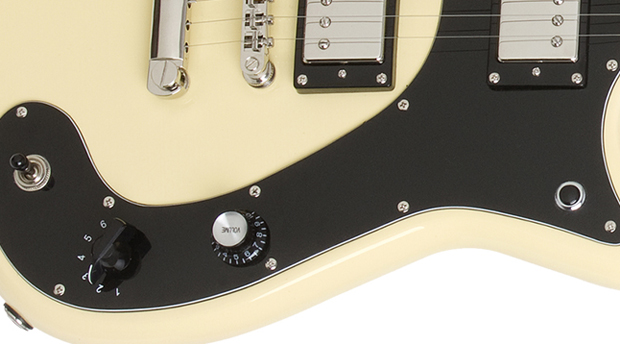
Epiphone has been an eye-catching brand pretty much from the company’s inception 140 years ago.
In the early part of the 20th century, Epiphone’s ornate, stylish New York City guitars provided stiff competition for the more staid models coming out of Gibson’s Kalamazoo, Michigan, plant. So it is ironic that Gibson ended up owning the Epiphone brand, which it purchased in 1957.
Ever since, Epiphone has played a unique, twofold role in the guitar market. On the one hand, the Epiphone product range has often shadowed Gibson’s output, offering affordable but high-quality iterations of iconic Gibson guitars, like the Les Paul, SG and Flying V, or models that fit somewhere “between” instruments in the Gibson line.
On the other hand, Epiphone has always endeavored to create a unique identity for itself. And this mission has given the world truly exceptional guitars, some of which have become classics. Others exude a kind of funky retro chic that has found favor with several high-profile modern and alternative rockers, including Ezra Koenig of Vampire Weekend (a Sheraton II), Nick Valensi of the Strokes (a Riviera), Frank Iero of the recently disbanded My Chemical Romance (a Wilshire Phant-o-matic bulit upon the body shape of the company’s 1959 Wilshire model), Pete Doherty of the Libertines/Babyshambles (a Coronet and, previously, an Olympic) and Brian Aubert of Silversun Pickups (a Sheraton II).
It’s really a “best of both worlds” scenario. A mid-Sixties Epiphone Crestwood or a switch-adorned 1963 Professional looks not unlike the kind of pawnshop guitar brought into vogue by postmodern bluesmen like Jack White or Dan Auerbach of the Black Keys.
But these are well-made American guitars, so they sound great and are much more reliable than Japanese guitars from the Sixties, budget department store brands from the same era, or other swap meet specials. All of which makes certain vintage and reissue Epiphones an ideal choice for players who wouldn’t be caught dead with a Strat, Les Paul or other “normal” guitar. Epiphones possess their own style and cred, having figured prominently in the music of the Beatles, the Stones and other classic groups. Even Prince got into the act recently, making headlines by smashing a 1961 Crestwood on Late Night with Jimmy Fallon.
[[ CONTEST: Enter to Win a New Epiphone Wilshire Phant-o-Matic Guitar! ]]
Many of Epiphone’s unique and innovative midcentury guitar designs were spearheaded by a gentleman named Andy Nelson, who joined the Gibson staff as a clinician and salesman in 1957 and moved over to Epiphone sales in 1962. The late Fifties and early Sixties were a fertile time for the company. A terrific trio of solidbodies came along in 1959: the Crestwood, the Coronet and the Wilshire. Initially they boasted symmetrical, double-cutaway bodies, not unlike a Gibson SG, only with rounded, rather than pointy, horns. Like all Epiphones from this period, they sported either P-90s or mini-humbuckers, since standard humbuckers were strictly reserved for Gibsons back then.
The little details on these early Sixties Epiphones just scream antique-shop cool. The screw-on nameplates that adorn the headstocks and primitive-looking vibrato arms all speak of an endearingly low-budget design approach that has retrospectively acquired a charm all its own.
Crestwoods, Wilshires and Coronets got even groovier around 1963 when they acquired six-on-a-side “batwing” headstocks—one of Andy Nelson’s aesthetic contributions—and a new asymmetrical shape that was nonetheless very squared off and simple. The same pawnshop allure draws the eye to the Epiphone Newport, an early Sixties bass that two decades later would find favor with Colin Moulding of XTC.
There were a few years in the early Sixties when Epiphone went a bit overboard with the kind of tiny tone switches that would soon figure prominently on Japanese imports. Perhaps the most extreme of these was the 1963 Professional model, with seven switches and five knobs arrayed along its pickguard. This was part of another Nelson-era innovation: an attempt to relocate control switches and circuitry from the amplifier onto the guitar body. Of course, the switches worked only with a matched Epiphone amp, but so much the better for sales, no?
Well, no, actually. But a 1963 Pro is still a stylish ax, even if some of the switches don’t do anything when mated with your Fender, Marshall or Divided by 13 amp. Epiphone’s 1964 Caiola Custom is also well endowed with arcane-looking switches. The instrument was a signature model for session guitarist Al Caiola, who played on timeless early Sixties tracks, like Dion’s “Runaround Sue” and Ben E. King’s “Stand By Me.”
The Epiphone Caiola model is a kind of down-market cousin to Gibson signature guitars like the Barney Kessel and the Tal Farlow from the same period. The nameplate shield attached to the Caiola’s trapeze tailpiece is a dead ringer for the Gibson Kessel nameplate, and either one could double as the insignia for some elite prep school or club.
Which was kind of the Epiphone vibe at the time. Many of the model names from this period—Crestwood, Wilshire, Rivoli and so on—sound like the names of exclusive country clubs, tony British boarding schools or international jet-set watering holes. The same holds true for the names attached to a trio of Epiphone thinline electrics, the Sheraton, Casino and Riviera.
These are definitely more upmarket than most of the Epiphone solidbodies from the same period, but they possess a certain outsider sexiness. The Sheraton, an adaptation of a pre-Gibson Epiphone archtop, came along in 1958; the Casino was born in 1961, and the Riviera in 1962.
All three guitars were patterned closely after Gibson’s ES line, which included the 330, 335, 345 and 355. The Sheraton and Riviera are semihollow instruments with a central body block like the ES-335, which tends to render these guitars a little more impervious to unwanted feedback than their fully hollowbody cousin, the Casino. But of the three, the Casino is quite arguably the bigger star.
The Casino ascended to supreme coolness in tandem with Beatlemania. In late 1964, Paul McCartney purchased his very own sunburst, Bigsby-equipped Casino. He’d been impressed by a thinline hollowbody electric owned by his friend, bluesman John Mayall, and so went around London looking for one of his own.
He may have chosen the Casino—as opposed to, say, a 335 or some other thinline archtop—because he was looking for a guitar with a Bigsby tailpiece, and the Casino was the only thinline hollowbody he could find with one. But McCartney just seemed to dig Epiphones during this period. He famously played his Epiphone Texan acoustic on “Yesterday,” and put his Casino to good use as well, employing it for his guitar solos on “Taxman,” “Ticket to Ride” and “Drive My Car,” among other tracks.
John Lennon and George Harrison acquired Casinos of their own in 1966, just in time for the Revolver album. One or both guitarists were often seen playing their Casinos in concert or television performances, and guitar players everywhere were quick to take note. (McCartney, being the group’s bassist, didn’t use his Casino for public appearances.) Lennon would later have his Casino sanded down to bare wood. He played it often from 1968 through the early Seventies, including at the Beatles’ final performance, on the London rooftop of their Apple headquarters, in early 1969. The guitar became one of the instruments most associated with Lennon.
Beyond the Beatles, Epiphone was one of the most ubiquitous guitar brands of the British Invasion era, sharing the limelight with Gretsch and Rickenbacker guitars and arguably outstripping Gibsons in popularity. Keith Richards and Brian Jones of the Rolling Stones also played Casinos, as did Dave Davies of the Kinks.
Brian Jones famously presented a Casino to his hero, bluesman Howlin’ Wolf. Paul Samwell-Smith of the Yardbirds, one of the most influential guitar bands of the era, played a hollowbody Epiphone Rivoli bass behind the group’s first two lead guitarists, Eric Clapton and Jeff Beck. The instrument was also played by Jimmy Page when he took over from Samwell-Smith as the Yardbirds’ bassist before moving on to lead guitar duties for the band.
After seeing Epiphones in the hands of these British invaders, countless mid-Sixties garage bands outfitted themselves with Epiphone guitars and basses of their own, which is how the brand comes by its impeccable pedigree of garage band coolness. Even Paul Revere and the Raiders, the archetypal American garage band, went through an Epiphone phase, although they are more closely associated with Vox.
But soon, the iconic American-made Epiphones of the Fifties and Sixties would go out of production, making them increasingly rare. That’s because, in 1969, Epiphone manufacturing moved far east, to the Matsumoku factory in Japan. “Made in Japan” is often a negative tag, particularly in the context of Seventies guitars. But viewed from a post-modern retro garage band perspective, Japan is definitely cool. Several of the Japanese-made Epiphone models from this period have become noteworthy either for their celebrity association or delightfully funky weirdness.
Early in Nirvana’s career, Kurt Cobain played an early Seventies Epiphone ET-270, a guitar with a Strat-like solidbody shape and somewhat incongruous Gibson-esque headstock. Cobain employed the guitar on Nirvana’s 1989 debut album, Bleach. And real Nirvana diehards know that Cobain smashed the guitar onstage at the Pyramid club in New York City in 1990. But then, Kurt smashed a lot of guitars.
By the mid Seventies, another effort was underway to give Epiphone guitars their own distinctive look and style. One of the more interesting products of this initiative was the Epiphone Scroll Series. These were double-cutaway instruments with beveled edges all around the guitar’s solid body and—most distinctively—a prominent carved scroll on the upper cutaway. While parallels have been drawn to the Gibson F-5 mandolin, which also boasts an upper-body scroll, the Epiphone Scroll Series guitars seem more akin to weird and wonderful mid-Sixties Italian brands like Eko or Wandre.
Around this same time, in 1979, Epiphone introduced the Genesis soldbody electric guitar, one of the company’s most original and forward-thinking body designs. The guitar’s mahogany body had shallow double cutaways that gave it a trim, streamlined and modern appearance—just the thing for a guitar intended to provide Epiphone with a new beginning.
Its electronics were, likewise, designed for the times. Coil tapping was then a new concept for guitarists, and the Genesis featured two coil-tapped humbuckers. The result was a bold, warm and sustaining sound that was perfect for hard rock as well as jazz fusion. The guitars were produced until only 1981, but Epiphone has brought the Genesis back this year with the Ltd. Edition Genesis Deluxe PRO, which feature coil tapping, Epiphone ProBucker pickups, Grover tuners, AAA quilted-maple veneer tops, and four color finishes, including Black Cherry, Midnight Ebony, Midnight Sapphire and Vintage Sunburst. At a street price of just $499, the guitars continue Epiphone’s tradition of providing quality at an affordable price.
In 1986, Gibson/Epiphone came under the business leadership of its current owners, Henry Juszkiewicz and Dave Berryman. By 1991, the Coronet was back in the product line and being made in America once again. The body was reminiscent of the classic Sixties Coronets, but the instrument was saddled with an incongruent heavy metal “hockey stick” headstock. Curious, indeed. But the catalog does mentions the instrument’s “hip, stripped and funky look,” hinting at some impetus toward a minimalist, outsider aesthetic.
The picture came into clearer focus when Jim “Epi” Rosenberg came onboard as Epiphone’s product manager in 1992. Not long after, Coronets started looking more like their Sixties namesakes. And while the company certainly courted mainstream players like Chet Atkins and Jeff “Skunk” Baxter as endorsees, it also made a clear play for the emergent grunge/alternative rock market. This much is manifestly clear in the 1994 catalog, which features photos of Epiphone-toting guys and girls decked out in standard-issue grunge wear: heavy Doc Martens–style boots and plenty of plaid. The female models were a bit too upscale and under-tattooed to pass as genuine grunge chicks, but the intent was certainly in tune with the times.
Britpop was the other big rock phenomenon of the Nineties, and Epiphone was fortunate to enjoy an extended relationship with guitarist and tunesmith Noel Gallagher of Oasis, the band that was pretty much the Beatles of Britpop. Gallagher had played a number of Epiphone guitars early in Oasis’ career. He employed an Epiphone Les Paul on sessions for the quintet’s 1994 debut album, Definitely Maybe, and a Sixties Riviera on the follow-up, 1995’s (What’s the Story) Morning Glory.
He also prominently played a Sixties Sheraton, which became the basis for Epiphone’s Noel Gallagher Supernova model in 1997, finished in the light-blue hue of Gallagher’s favorite soccer team, Manchester City. This was followed by a second Gallagher Supernova in 2000, which was a more accurate copy of the guitarist’s Sixties Sheraton, right down to its Union Jack body paint job. If ever there was an iconic Britpop instrument, this is it.
Epiphone continued to follow the sounds and styles of modern rock into the 21st century. New York City band the Strokes were at the vanguard of the garage rock resurgence of the early 2000s. A collaboration with Strokes guitarist Nick Valensi yielded a stylish signature model based on Valensi’s Nineties Riviera, which he’d retrofitted with P-92 pickups (P-90s made to fit humbucker routing). And in 2011, Epiphone teamed with guitarist Frank Iero of emo/punk darlings My Chemical Romance on a signature model called the Wilshire Phant-o-matic. The Wilshire had recently come back into production, with a style harking back to the model’s birth in 1959. Iero’s dual-humbucker signature ax has a vintage flair that looks fresh and new today.
And that’s really the appeal of the Epiphone models that came out of the company’s fertile 1959–’62 period. Classic but never clichéd, these guitars have woven their way throughout the modern rock landscape, flying under the radar at times but always seeming to re-emerge when the music gets really good.
Photo (above): Epiphone
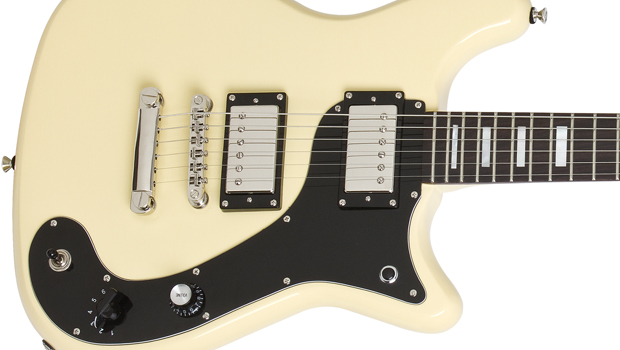
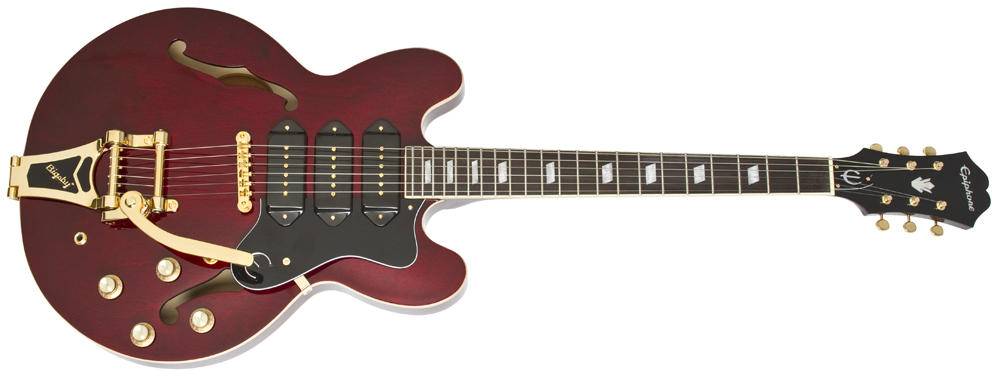
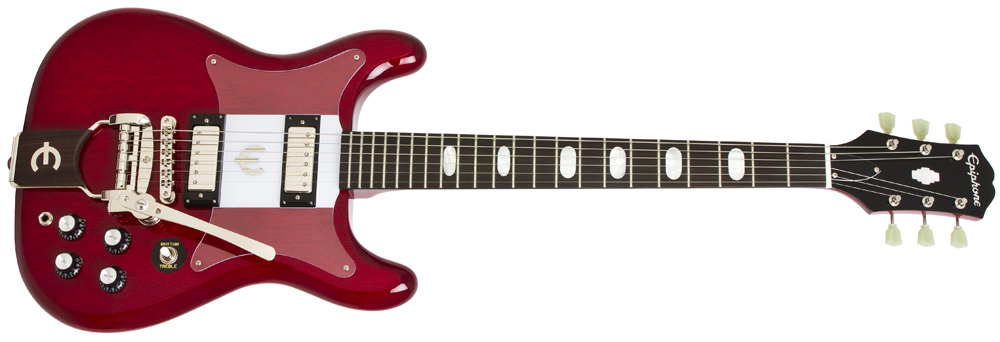
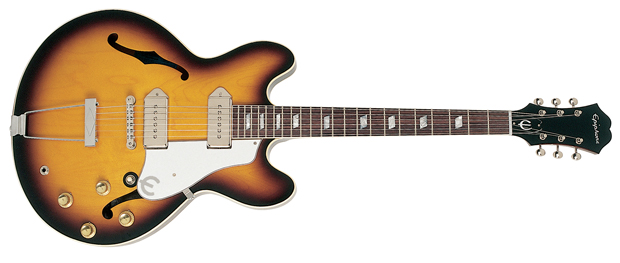
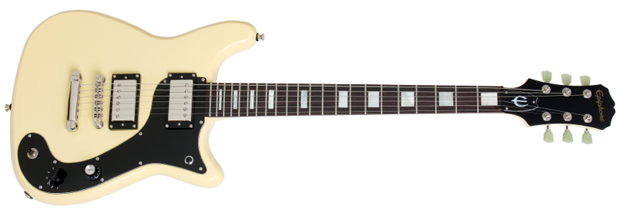
Get The Pick Newsletter
All the latest guitar news, interviews, lessons, reviews, deals and more, direct to your inbox!
In a career that spans five decades, Alan di Perna has written for pretty much every magazine in the world with the word “guitar” in its title, as well as other prestigious outlets such as Rolling Stone, Billboard, Creem, Player, Classic Rock, Musician, Future Music, Keyboard, grammy.com and reverb.com. He is author of Guitar Masters: Intimate Portraits, Green Day: The Ultimate Unauthorized History and co-author of Play It Loud: An Epic History of the Sound Style and Revolution of the Electric Guitar. The latter became the inspiration for the Metropolitan Museum of Art/Rock and Roll Hall of Fame exhibition “Play It Loud: Instruments of Rock and Roll.” As a professional guitarist/keyboardist/multi-instrumentalist, Alan has worked with recording artists Brianna Lea Pruett, Fawn Wood, Brenda McMorrow, Sat Kartar and Shox Lumania.
“It holds its own purely as a playable guitar. It’s really cool for the traveling musician – you can bring it on a flight and it fits beneath the seat”: Why Steve Stevens put his name to a foldable guitar
“Finely tuned instruments with effortless playability and one of the best vibratos there is”: PRS Standard 24 Satin and S2 Standard 24 Satin review

